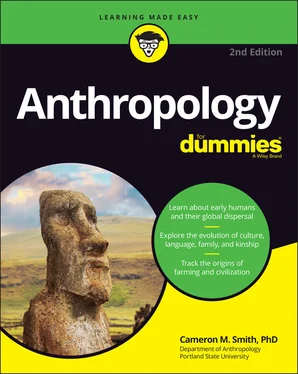These are fascinating issues considering that the first languages most likely had a strong gestural component, and you could potentially discover much about them by studying modern gesture. Figure 3-3 shows some polite gestures of 17th-century Europe; the upper left gesture is “adoration,” the upper right “reconciliation,” the lower left “impatience,” the lower right “demonstration,” and the middle “benediction.” You can easily imagine using these gestures in your own communication; think about how different communication is without them … for example, over email.

© John Wiley & Sons, Inc.
FIGURE 3-3:Author’s rendering of drawings in John Bulwer’s work on gesture in European society.
Cultural Anthropology: The Study of Living Societies
Whereas archaeology studies ancient cultures, cultural anthropology focuses on living societies. Some reasons include
An attempt to identify cultural similarities worldwide: Such similarities may offer very important insights into what it is to be human.
An attempt to identify cultural differences worldwide: Such differences can illustrate the diverse ways humans have found to survive across the globe and, in some cases, through time.
An attempt to correct supposedly common-sense ideas about humanity: This process is important because most cultures worldwide believe their own way of living is the most appropriate and right for all of humanity.
CULTURAL ANTHROPOLOGY: AN EQUAL-OPPORTUNITY WHISTLE-BLOWER
Attempting to rectify common-sense evaluations of the rest of the world is a sort of corrective for human perception of itself. The idea that one’s own culture is the best and most appropriate way to live is called ethnocentrism , and it’s been used to justify discrimination against people outside ones’ own culture for centuries and worldwide. Keep in mind that just because a cultural practice exists doesn’t necessarily mean that it’s good for the culture at large; like slavery, it may benefit a relative few at the expense of many. Robert G. Edgerton’s book Sick Societies demonstrates that many human cultural adaptations are actually maladaptations , adaptations that are actually bad for the society rather than beneficial. For example, some agricultural practices provide high yields in the short run but may burn out the soil in the long run.
Western civilization isn’t shy about pointing out obvious problems of its own — such as racial discrimination or the fact that women make significantly less money than men at the same jobs — and should remain open to the possibility that such problems are possible in other cultures. In this way, cultural anthropology isn’t a discipline focused on bashing Western civilization; it’s an objective science that doesn’t idealize any society over another.
Putting the culture in cultural anthropology
Whatever end you hope to achieve through cultural anthropology, the means are going to be a study of culture. Culture has been defined in many ways; I give you a definition in the section “ The biocultural animal” earlier in this chapter, and you can take entire graduate-level courses just to grapple with culture theory. Generally speaking, culture encompasses everything from attitudes toward material objects to philosophical, political, and religious concepts.
Important features of culture include the following:
Culture isn’t genetic; it’s learned. Each new generation doesn’t receive it in genes but from parents, siblings, and anyone else in the culture (largely through language).
Culture is shared among a population, but it allows variation within it. Individuals of a culture may have their own interpretations of the culture’s set of descriptions of the universe and instructions for how to live properly in it. This discrepancy is important because it recognizes a major characteristic of humanity: individuality, the fact that humans aren’t typically of one mind but rather are individuals with a great deal of individual personality (humans are messy in this way!).
Cultural information is often symbolic. Symbols — which are linguistic, visual, and gestural metaphors that stand for something else — are heavily influential in the communication of culture from one generation to the next.
Although cultural information rides in the brain, humans can also express it physically. Material objects — for example, seagoing canoes, totem poles, or sports cars — are also expressions of certain cultural ideas. Even the most apparently utilitarian artifacts, like writing pens, can and often do carry cultural information. A glitter-spangled, bubblegum-pink pen is more likely to belong to an adolescent girl than to a public official; the official probably requires a fancier pen to project a certain image in public ceremonies. Material objects, then, constitute culture; some call the study of such items the study of material culture. Because archaeologists study ancient cultures through their artifacts — which are material culture — they’ve made the most thorough studies of material culture.
Attempting to explain why humans do what they do
Cultural anthropologists have devised many fascinating and complex bodies of theory to explain humanity and the diversity and commonalities of human cultures. Among them:
Evolutionary approaches (including materialist approaches) that seek explanations by looking for the adaptive advantages of various cultural practices — such as cannibalism or social ranking — worldwide. These theories seem to explain some things, but critics argue that they ignore the significance of individual action, which is sometimes known as agency.
Functionalist approaches that understand elements of culture as each working in an integrated way to promote the culture’s welfare. Critics claim that these approaches ignore the importance of conflict, which is always present in culture (particularly those with social rank or class differences).
Postmodern approaches that focus on conflicts, individual agency, and other nonstandard aspects of culture. Critics argue that such approaches, though they admirably give voice to common people, often ignore physical, material, and evolutionary realities of the fact that humans are evolving animals.
As with single-factor attempts to describe all of cultural change, I can confidently say no one explanation of the complexity of culture has convinced all anthropologists of its validity; single-factor models never seem to pan out.
CULTURAL ANTHROPOLOGY VERSUS SOCIOLOGY
People often confuse cultural anthropology with the related discipline of sociology, but you can note at least two clear distinctions between the two fields:
Cultural anthropology focuses on nonindustrial societies. These groups are often called traditional societies because they have many things in common with societies that existed before the recent, massive global changes associated with post–World War II globalism. On the other hand, sociology tends to focus on industrial or Western civilization (particularly urban civilization).
Cultural anthropology tends to rely on direct interviews with the members of traditional societies. Many of these people don’t read or write, and sociologists tend to gather data with questionnaires.
Academic departments of sociology and anthropology often have close connections and sometimes merge, but their theoretical backgrounds are very different. Sociology’s roots are in economics and anthropology’s in the humanities. Although they share some similarities, it’s probably best to keep these fields separate.
Читать дальше













